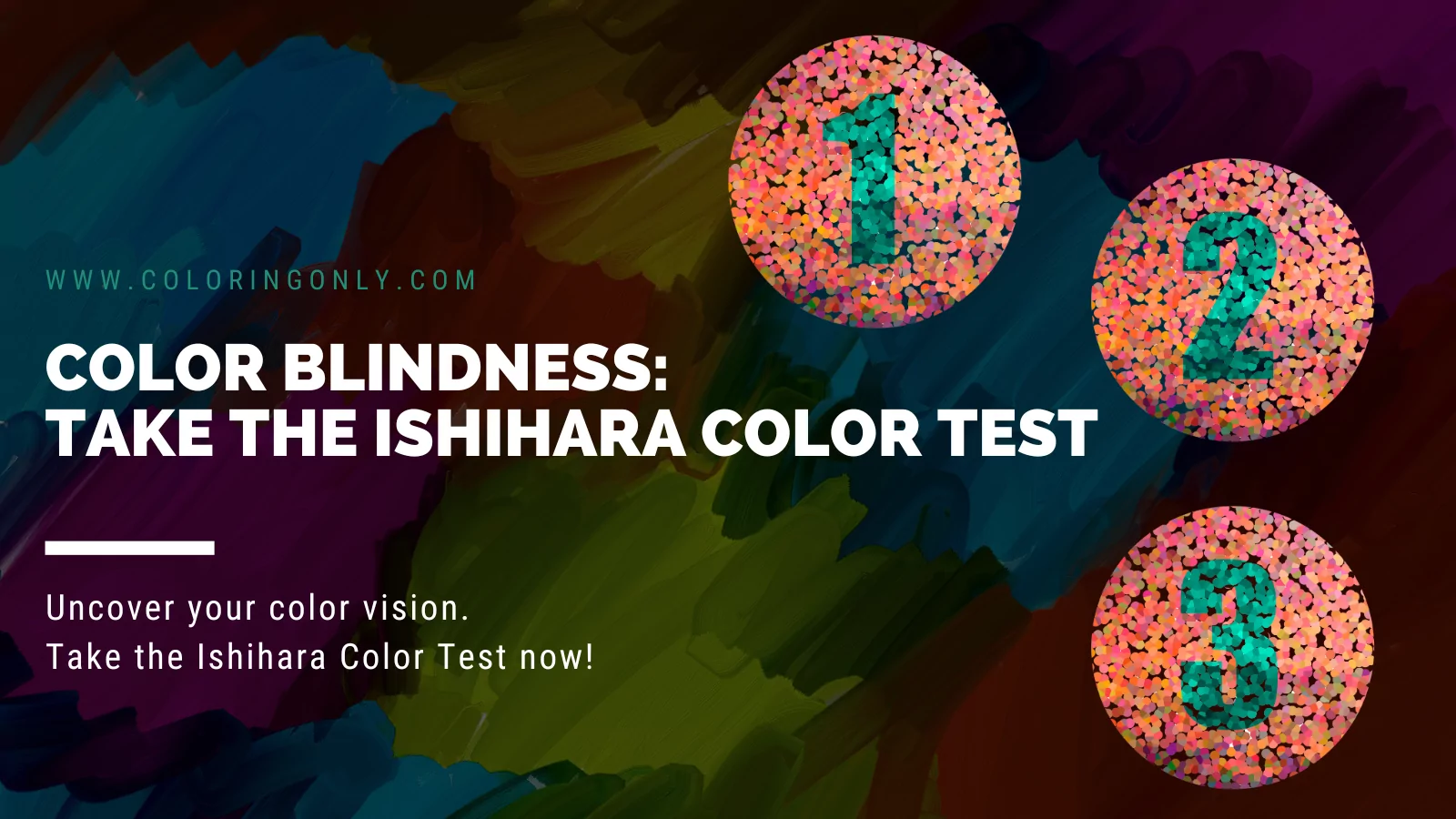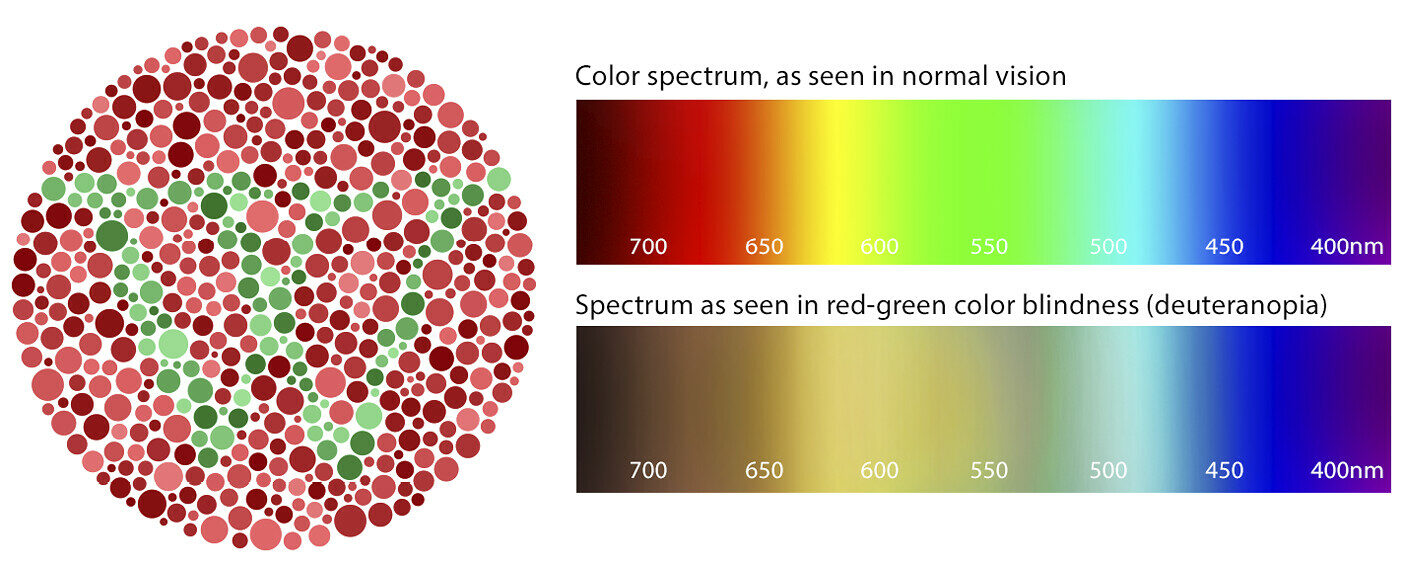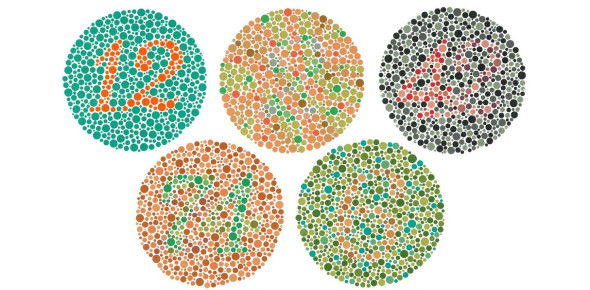
Color vision deficiency, commonly known as color blindness, affects millions worldwide. Among the various types, red-green color blindness is the most prevalent. To take the Ishihara Color Test, just start the Color Blind Test below. But before that, let’s delve into the intricacies of red-green color blindness, discuss the renowned Ishihara Color Test, and provide insights into managing this condition.
What is Red-Green Color Blindness?

Approximately 9 percent of males have some degree of red-green color blindness (deuteranopia) and cannot read the letter in the circular Ishihara color test at the left. The bottom color spectrum on the right simulates the spectrum as seen by people with red-green color blindness. (Via Web Style Guide)
Red-green color blindness is a genetic condition that impairs the ability to differentiate between red and green colors. It predominantly affects males and can vary in severity. Understanding this condition is crucial, especially for educators and parents, as it impacts learning and daily activities.
Causes and Types of Red-Green Color Blindness
The primary cause of red-green color blindness lies in genetic mutations affecting the X chromosome. Since this chromosome is responsible for carrying the genes that determine color vision, any alteration can lead to color vision deficiencies. There are two main types of red-green color blindness: protanopia, where individuals lack the red photopigment, and deuteranopia, where the green photopigment is absent.
Symptoms of Red-Green Color Blindness
Limited Color Perception
Individuals with red-green color blindness struggle to differentiate between red and green hues, often perceiving them as shades of gray or other colors.
Difficulty in Color-Dependent Tasks
Tasks reliant on color perception, such as identifying traffic signals, reading maps, or interpreting color-coded information, pose significant challenges for those with red-green color blindness.
Genetic Inheritance
Since red-green color blindness is primarily inherited, individuals with a family history of the condition are more likely to experience it themselves.
Implications for Education and Daily Life
Educational Challenges
In educational settings, red-green color blindness can impact learning, particularly in subjects where color-coded information is prevalent, such as science and geography. Educators must be aware of this condition to accommodate affected students appropriately.
Career Limitations
Certain professions, such as those in aviation, electronics, and graphic design, may pose challenges for individuals with red-green color blindness due to their reliance on color-coded information.
Safety Concerns
Safety hazards can arise in daily life, as individuals with red-green color blindness may struggle to identify warning signs, signals, or hazards marked with red or green colors.
The Ishihara Color Test
One of the most renowned tools for diagnosing color blindness is the Ishihara Color Test. Developed by Dr. Shinobu Ishihara, this test utilizes a series of plates containing colored dots. Individuals with normal color vision can perceive numbers or patterns within the dots, while those with color vision deficiency may struggle or fail to discern them.
The Ishihara Color Test serves as a fundamental tool in identifying red-green color blindness. It is accessible, reliable, and widely used by healthcare professionals worldwide.
How Does the Ishihara Test Work?
The test comprises plates with colored dots arranged in patterns. Each plate contains a number or shape embedded within the dots. Individuals with normal color vision can easily identify these figures, while those with color blindness may perceive a different number or no figure at all.
Importance of Early Detection
Early detection of color blindness is essential for children, as it can impact their academic performance and daily interactions. Educators and parents should be vigilant for signs of color vision deficiency and encourage regular screenings using tools like the Ishihara Color Test.
Managing Color Blindness
While red-green color blindness is incurable, individuals can adopt strategies to manage the condition effectively.
- Color-Coded Systems: Implementing alternative color-coded systems that rely on easily distinguishable hues can enhance accessibility for color-blind individuals.
- Visual Aids: Utilizing visual aids such as color-blind-friendly charts and diagrams ensures inclusivity in educational and professional settings.
- Awareness and Education: Promoting awareness and understanding of red-green color blindness fosters empathy and facilitates accommodations in various environments.
- Accommodations and Adaptations: Implementing accommodations, such as providing alternative color-coded materials or using symbols and patterns alongside colors, can help mitigate the challenges faced by individuals with red-green color blindness
- Accessibility Measures: Developing technologies and design practices that consider color blindness can enhance accessibility for a broader range of individuals in various settings, from digital interfaces to urban planning.
Understanding red-green color blindness and its impact is vital for fostering inclusivity and accessibility. The Ishihara Color Test serves as a valuable tool in diagnosing this condition, enabling early intervention and support. Raising awareness and implementing inclusive practices can create environments where individuals with color vision deficiency can thrive. Early detection is key, so don’t hesitate to take the Ishihara Color Test today.













